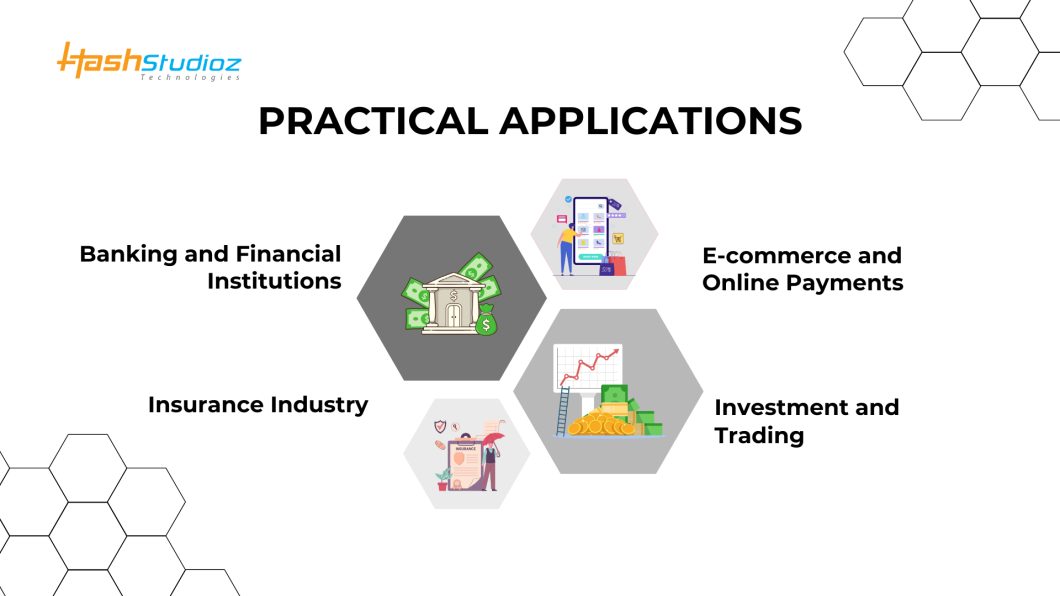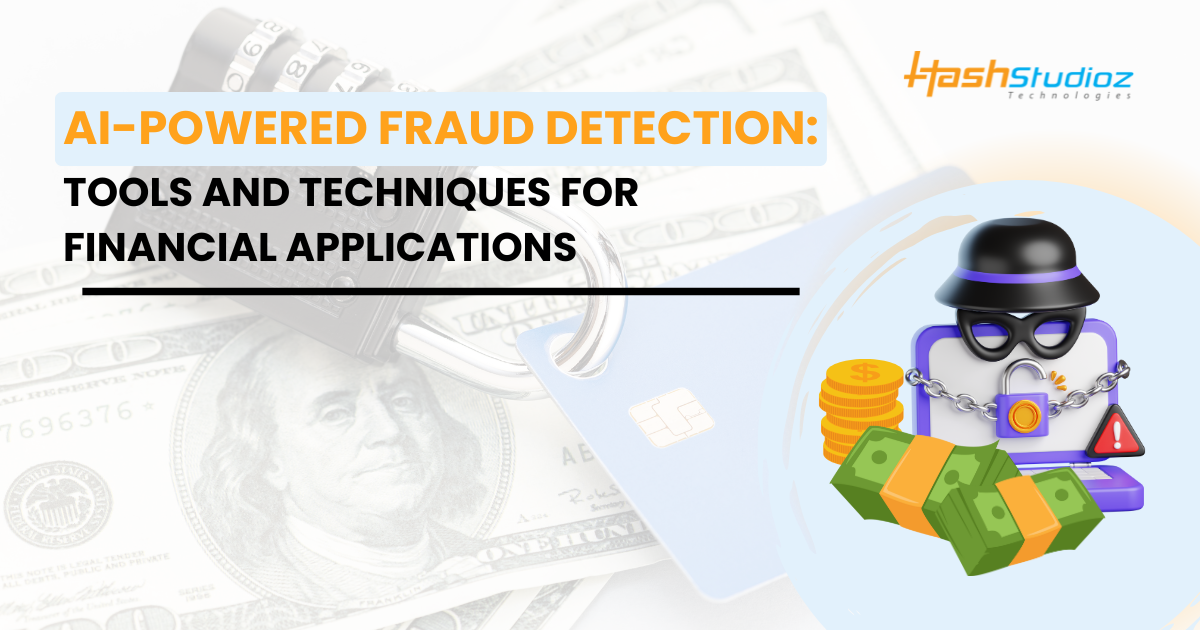In an era where financial fraud is becoming increasingly sophisticated, traditional detection methods are no longer sufficient. This blog explores how Artificial Intelligence (AI) is revolutionizing fraud detection in the financial sector. We will delve into the various AI tools and techniques, such as machine learning, deep learning, and natural language processing, that are being employed to enhance security and efficiency.
Table of Contents
- Introduction
- Understanding AI in Fraud Detection
- Core AI Techniques for Fraud Detection
- AI-Powered Fraud Detection Tools and Platforms
- Practical Applications in Financial Sectors
- Implementing AI Fraud Detection: Best Practices
- The Future of AI in Fraud Detection
- The Role of HashStudioz in AI-Powered Fraud Detection
- Conclusion
Introduction
The Growing Threat of Financial Fraud
Financial fraud poses an escalating threat to businesses, consumers, and financial institutions worldwide. With the surge in digital transactions and online banking, fraudsters are continuously developing new tactics to exploit vulnerabilities. Recent reports indicate that financial fraud costs organizations billions annually, making it a critical issue that demands immediate attention.
The Limitations of Traditional Fraud Detection Methods
Historically, fraud detection relied on rule-based systems and manual intervention, often resulting in high false positive rates and delayed responses. These traditional methods struggled to adapt to new and emerging fraud techniques, rendering them inefficient in today’s fast-paced digital environment.
The Rise of Artificial Intelligence in Fraud Prevention
Enter Artificial Intelligence (AI). Over the past decade, AI has revolutionized the fraud detection landscape by providing smarter, faster, and more accurate solutions. AI’s capability to process massive amounts of data in real-time and identify patterns beyond human capabilities is transforming how financial institutions prevent fraud.
Scope of This Blog: Focus on Tools and Techniques
In this blog, we will explore the AI tools and techniques that are reshaping fraud detection in financial applications. We’ll examine how AI techniques like machine learning, deep learning, and natural language processing are being utilized to prevent fraud, improve accuracy, and reduce losses. Additionally, we will touch upon the significance of fintech app development and mobile app development in enhancing fraud detection capabilities.
Understanding AI in Fraud Detection
What is Artificial Intelligence?
Artificial Intelligence refers to the simulation of human intelligence in machines programmed to think, learn, and make decisions. In the context of fraud detection, AI systems are trained to recognize patterns and behaviors indicative of fraudulent activity.
Key AI Concepts for Fraud Detection
- Machine Learning (ML): ML algorithms enable systems to learn from historical data and make predictions about new, unseen data. In fraud detection, ML can identify patterns in transaction data and predict potential fraud.
- Deep Learning (DL): A subset of ML, deep learning employs neural networks with multiple layers to analyze complex patterns. It is particularly effective for tasks like image recognition and intricate transaction analysis.
- Natural Language Processing (NLP): NLP allows machines to understand and interpret human language. In fraud detection, NLP analyzes textual data, such as claims or social media activity, to identify signs of fraud.
- Anomaly Detection: AI techniques can identify anomalies in data that deviate from normal behavior, often a key sign of fraudulent activity.
How AI Enhances Fraud Detection Capabilities
AI’s ability to learn from vast datasets allows it to adapt to new fraud tactics, make accurate predictions, and respond to suspicious activity in real-time. This reduces reliance on static, rule-based systems and enables more proactive fraud prevention.
Also Read:- The Role of Artificial Intelligence in Shaping the Future of Fintech
Core AI Techniques for Fraud Detection
Supervised Learning: Predicting Fraud Based on Labeled Data
Supervised learning uses labeled datasets (data with known outcomes) to train models that can predict future events. In fraud detection, supervised learning is often used with classification algorithms like:
- Logistic Regression
- Decision Trees
- Random Forests
These algorithms can predict the likelihood of fraud in transactions such as credit card purchases or loan applications.
Use Cases:
- Credit Card Fraud: Predicting whether a transaction is fraudulent based on previous labeled data.
- Loan Application Fraud: Identifying whether an applicant’s details are likely fraudulent.
Unsupervised Learning: Identifying Anomalies and Patterns
Unsupervised learning works with unlabeled data to find hidden patterns and anomalies. Algorithms like K-Means and DBSCAN cluster data points to identify unusual behavior. Anomaly detection algorithms like Isolation Forest and One-Class SVM are particularly useful for identifying unusual patterns that may signal fraud.
Use Cases:
- Money Laundering: Detecting unusual financial activity patterns.
- Unusual Transaction Patterns: Identifying anomalous transactions that deviate from normal behavior.
Deep Learning: Advanced Pattern Recognition
Deep learning, through Neural Networks, excels at recognizing complex patterns in large datasets. Recurrent Neural Networks (RNNs) are used for time-series data, while Convolutional Neural Networks (CNNs) are effective in image-based fraud detection, such as forged documents or identity theft.
Use Cases:
- Complex Transaction Analysis: Identifying sophisticated fraudulent schemes.
- Identity Verification: Using image-based AI to detect forged IDs or documents.
NLP: Analyzing Textual Data for Fraudulent Activity
NLP enables AI systems to analyze large amounts of unstructured text data, such as insurance claims, emails, or social media posts, to detect fraud. Techniques like Sentiment Analysis and Entity Recognition help identify fraudulent claims or misleading information.
Use Cases:
- Insurance Claims Fraud: Analyzing claims for inconsistencies or signs of deception.
- Social Media Fraud: Detecting fraudulent activity or misleading statements on social platforms.
AI-Powered Fraud Detection Tools and Platforms
Overview of Leading AI Fraud Detection Solutions
Several advanced platforms offer AI-powered fraud detection solutions, leveraging machine learning and deep learning to protect financial transactions. These tools can detect fraud with minimal human intervention and in real-time.
Cloud-Based AI Platforms
- AWS Fraud Detector: Amazon’s platform offers pre-built models and a customizable framework to identify potentially fraudulent activities.
- Google Cloud AI Platform: Provides machine learning and AI services to detect fraud in various industries, including finance and e-commerce.
Specialized Fraud Detection Software
Platforms like SAS Fraud Management and FICO Falcon Fraud Detection offer industry-specific fraud detection solutions, utilizing advanced AI techniques to identify fraud across different sectors.
Open-Source AI Libraries and Frameworks
Libraries like TensorFlow and Scikit-learn provide the tools to develop custom fraud detection models. These open-source frameworks are popular for their flexibility and scalability.
Choosing the Right Tools for Your Needs
Selecting the right AI tool for fraud detection depends on factors like the volume of transactions, the complexity of potential fraud, and integration with existing systems.
Practical Applications in Financial Sectors

Banking and Financial Institutions
AI is pivotal in detecting credit card fraud, anti-money laundering (AML) efforts, and loan application fraud. Machine learning models can analyze vast amounts of transaction data to predict fraudulent behavior and prevent financial crimes.
Insurance Industry
Fraudulent insurance claims are a major concern for insurers. AI tools are used to detect suspicious claims and identify patterns that suggest fraudulent activity.
E-commerce and Online Payments
AI is essential in preventing payment fraud and account takeover attacks in the e-commerce sector. Fraud detection models can analyze buying patterns and user behavior to identify fraudulent transactions in real-time.
Investment and Trading
In the investment sector, AI helps detect market manipulation and insider trading, providing better surveillance of trading activities and ensuring a level playing field for all participants.
Also Read:- How Machine Learning in Banking Helps in Fraud Detection
Implementing AI Fraud Detection: Best Practices
Data Collection and Preprocessing
High-quality data is critical for building effective AI fraud detection systems. Proper data preprocessing, including normalization and handling missing values, is essential for training accurate models.
Model Selection and Training
Choosing the right AI model depends on the specific fraud detection problem. For example, supervised learning is effective for predicting fraud, while unsupervised learning is better for anomaly detection.
Model Evaluation and Validation
Evaluating the performance of AI models using metrics like precision, recall, and F1 score is essential to ensure the model’s effectiveness in detecting fraud.
Real-Time Fraud Monitoring and Alerting
Real-time monitoring is critical to preventing fraud before it occurs. AI models should be integrated into systems that can trigger alerts and take automated actions when fraud is detected.
Continuous Improvement and Model Retraining
Fraud tactics evolve constantly. Continuous retraining of AI models with new data ensures they remain effective at detecting emerging threats.
Addressing Bias and Ethical Considerations
AI systems must be carefully designed to avoid bias. It is important to ensure that models are trained on diverse datasets and do not unfairly discriminate against certain groups of individuals.
The Future of AI in Fraud Detection
Emerging AI Technologies
Technologies like Graph Neural Networks are showing promise in fraud detection by providing more accurate analysis of relationships between data points, helping to identify complex fraud schemes.
The Role of Explainable AI (XAI)
As AI becomes more prevalent, the need for explaination is growing. Explainable AI (XAI) helps financial institutions understand how AI models make decisions, which is critical for regulatory compliance.
Predictive Analytics and Proactive Fraud Prevention
AI will continue to evolve from reactive fraud detection to proactive prevention. Predictive analytics will allow systems to anticipate fraud before it happens.
Collaboration and Data Sharing
Collaborations between financial institutions and sharing of data will help AI systems detect fraud more accurately by leveraging a broader range of information.
The Evolving Landscape of Cybercrime and AI’s Countermeasures
As cybercriminals develop more sophisticated techniques, AI will continue to evolve to stay ahead of the curve, providing cutting-edge countermeasures to protect financial systems.
The Role of HashStudioz in AI-Powered Fraud Detection
Custom AI Solutions for Financial Apps
HashStudioz specializes in developing mobile applications with integrated AI-driven fraud detection systems. By utilizing machine learning (ML) and deep learning (DL), they enable businesses to detect fraudulent activities in real-time, enhancing security and minimizing risks across financial platforms.
Behavioral Biometrics and Advanced Authentication
HashStudioz goes beyond traditional fraud detection by incorporating behavioral biometrics and advanced authentication methods into mobile apps. This includes analyzing user behavior like typing patterns and device usage, adding an extra layer of security to prevent fraud and identity theft.
Tailored Solutions for Different Industries
HashStudioz offers bespoke fraud prevention tools designed to meet the specific needs of various industries, such as banking, e-commerce, and lending. Their custom solutions ensure that each platform receives the optimal protection it needs against evolving fraud tactics.
Seamless User Experience with Enhanced Security
By integrating fraud detection features without compromising the user experience, HashStudioz ensures that financial transactions remain secure while being fast and seamless. Their focus on maintaining a balance between security and usability helps businesses build trust with customers.
Building a Secure Financial Ecosystem
Through their innovative approach to AI integration, HashStudioz is helping to shape a safer, more secure financial ecosystem. Their detection solutions offer real-time protection, ensuring that businesses stay ahead of potential threats while safeguarding their clients’ financial data.

Conclusion
Recap of Key AI Tools and Techniques
AI tools like machine learning, deep learning, and NLP are transforming fraud detection, enabling faster, more accurate responses to fraudulent activity.
The Importance of Staying Ahead in Fraud Prevention
Financial institutions must stay ahead of fraudsters by adopting AI-powered solutions that can quickly adapt to emerging threats. Additionally, the integration of fintech app development and mobile app development plays a crucial role in enhancing the overall security and efficiency of fraud detection systems.

